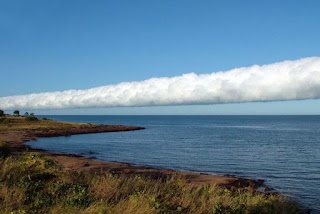The Morning Glory cloud is a rare meteorological phenomenon consisting of a low-level atmospheric solitary wave and associated cloud, occasionally observed in different locations around the world. The wave often occurs as an amplitude-ordered series of waves forming bands of roll clouds.
 |
| Morning Glory Clouds Over Australia |
The southern part of the Gulf of Carpentaria in Northern Australia is the only known location where it can be predicted and observed on a more or less regular basis due to the configuration of land and sea in the area.
Description
A Morning Glory cloud is a roll cloud, or arcus cloud, that can be up to 1,000 kilometres (620 mi) long,1 to 2 kilometres (0.62 to 1.24 mi) high, often only 100 to 200 metres (330 to 660 ft) above the ground. The cloud often travels at the rate of 10 to 20 metres per second. Sometimes there is only one cloud, sometimes there are up to ten consecutive roll clouds. Three distinct types of Morning Glory clouds have been identified.
 |
| .. Stratocumulus (Morning Glory) clouds |
The Morning Glory is often accompanied by sudden wind squalls, intense low-level wind shear, a rapid increase in the vertical displacement of air parcels, and a sharp pressure jump at the surface. Cloud is continuously formed at the leading edge while being eroded at the trailing edge.Showers or thunderstorms may develop in its wake. In the front of the cloud, there is strong vertical motion that transports air up through the cloud and creates the rolling appearance, while the air in the middle and rear of the cloud becomes turbulent and sinks. The cloud quickly dissipates over land where the air is drier.
 |
| A 'Morning Glory' cloud, comes towards land near Burketown the southern coast of |
Morning Glory clouds can be observed from Burketown from late September to early November. The town attracts glider pilots intent on riding this phenomenon. There are generally only a handful of well formed spectacular clouds during this period at Burketown. During the 2012 season there were only four to be seen from there, but quite a few ragged unspectacular cloud lines were seen. Often they start to break up before arriving at Burketown or pass to the north and only stay well formed over water. In an aircraft there is a significantly better chance of sighting the cloud.
History of exploration
Unusual cloud formations have been noticed here since ancient times. The local Garrawa Aboriginal people called it kangólgi. Royal Australian Air Force pilots first reported this phenomenon in 1942.
 |
| The morning glory cloud forms over Sweers Island in the Gulf. |
The Morning Glory cloud of the Gulf of Carpentaria has been studied by multiple teams of scientists since the early 1970s. The first studies were published by Reg H.Clarke (University of Melbourne). Multiple studies have followed since then, proposing diverse mathematical models explaining the complex movements of air masses in the region.
#Meteorological#Phenomenon#Morning-Glory-Cloud#Roll-cloud#Arcus-cloud,
#Meteorological#Phenomenon#Morning-Glory-Cloud#Roll-cloud#Arcus-cloud,
No comments:
Post a Comment